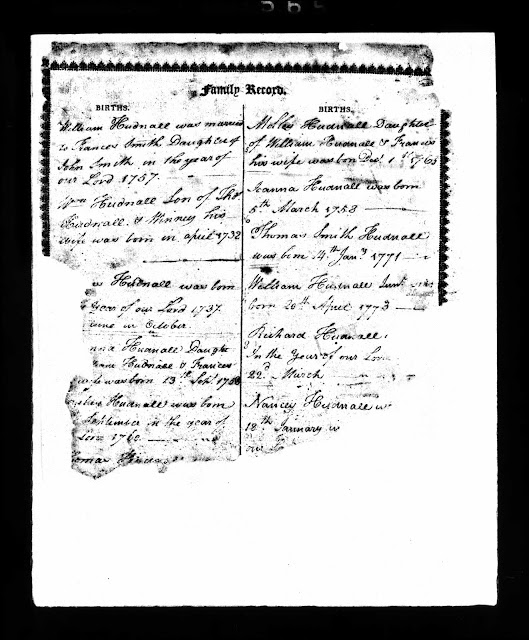I love reading military pension applications. By the time the government offered a pension most who served had died. The ones who survived long enough to apply were old men, and the government expected them to remember details of long-ago service.
John Hudnall, ancestor of Charles Rutledge, was awarded a pension based on his service in the Bedford County, Virginia militia. According to his deposition, he did nothing during his service except march. That's probably pretty typical of soldiers in any war.
He was drafted the end of May or first of June, 1780, and served 6 or 7 weeks guarding some Tories and an ammunition magazine in New London. When he filed his pension application he could not remember the names of any officers, except Maj. Nathan Reid of the regular army, who he thought was stationed in New Bedford.
He was drafted again in January 1781 and served at least 3 months. The militia rendezvoused at New London, Virginia, and marched through Prince Edward, Dinwiddie and Petersburg to Cabbin Point in Surry County, Virginia where they were placed under the command of Gen'l. Peter Muhlenberg).
According to his deposition, "After remaining at Cabbin Point for some time he was marched some distance to a place called McKey’s Mills where the troops had a day of rejoicing on account of Gen’l. Morgan’s victory over the British, he thinks, at the Cowpens . He was then marched about to several places southeast of Petersburg under the same officers. He thinks at a place called Cobb’s[?] old field the army was drawn up in line & volunteers invited out to go & watch the movements of the British, then in possession of Portsmouth & Norfolk Va. He was one of the number who volunteered on the occasion under his officers aforesaid & marched from thence to the lower part of Virginia some distance south east of Portsmouth to a place called Edmund’s Hill near to a fort in which the British were stationed. His field officers in this volunteer expedition were Col. Merriweather [sic: Meriwether] & Maj DeCloman, a Frenchman. On their march to this place a British picket guard by some French light horse & taken. At one time the American troops were drawn up in line of battle within cannon shot of the fort & offered a fight, but the enemy would not come out, tho’ they fired a few shots. The troops then went back into quarters & kept up scouting parties until near the end of the tour."
"They suffered every kind of hardship. He marched across the Dismal Swamp, 8 or 10 miles on logs to Prince George court house Va. where he was discharged, by whom he cannot recollect, sometime in April 1781."
Again sometime about the last of May or first of June 1781. he was drafted into the service of the United States from the militia of Bedford County and served at least seven weeks: His company rendezvoused at New London & marched through Buckingham & Cumberland Counties & crossed the James River at Jude’s Ferry [17 miles above Richmond]. He did not march thro’ Richmond, because it was reported the small pox was there; but continued on to Bottom’s Bridge below Richmond [on Chickahominy River 10 miles east of Richmond], commanded by Gen’l. LaFayette & from there he marched to Mobbin’s Hills [sic: Malvern Hill in Charles City County].
The troops were marched about the country continually & sometimes thro’ mud half leg deep in the lowlands of Chickahominy River. He was finally marched to New Castle on Pamunkey River, where he received a discharge sometime in July 1781 from Capt. Leftwich, but it was not written.
The pension file includes a genealogical treasure–pages from the family Bible where births, deaths and marriages were recorded. I once heard an English genealogist say a major difference between research in England and the US was these Bible records because the literacy rate in America was so high.
The pension file includes a genealogical treasure–pages from the family Bible where births, deaths and marriages were recorded. I once heard an English genealogist say a major difference between research in England and the US was these Bible records because the literacy rate in America was so high.











No comments:
Post a Comment